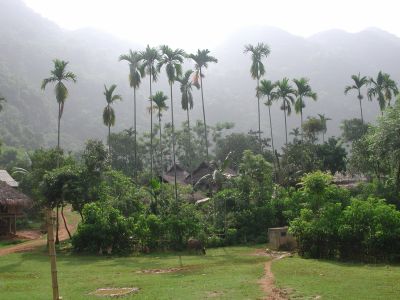Pu
Luong Nature Reserve

Alternative site
name(s)
Pu Luong
Province(s)
Thanh Hoa
Area
17,662 ha
Coordinates
20o21' – 20o34'N, 105o02' – 105o20'E
Distance(s)
From Hanoi: 180 km
Eco-tours
Trekking, Mountain Biking … Contact
us for more information
Topography
and hydrology
Pu Luong proposed
nature reserve is located in Quan Hoa and Ba Thuoc
districts, in north-western Thanh Hoa province. To the north-east,
the nature reserve is bordered by Mai Chau, Tan Lac and
Lac Son districts, Hoa Binh province. The proposed nature
reserve lies along two parallel mountain ridges, that run
from north-west to south-east, and are bisected by a central
valley. This valley contains several human settlements and
a large area of agricultural land, and, hence, is not included
within the proposed nature reserve.
The two mountain ridges
in the proposed nature reserve have starkly contrasting
landforms, based on their different substrates. The smaller,
south-western ridge is made up of mostly igneous and metamorphic
rocks, and consists of rounded forested hills and wide,
shallow valleys. The larger, north-eastern ridge is composed
of heavily dissected limestone karst, and is a continuation
of the limestone range that runs from Cuc
Phuong National Park to Son La province. Elevations
in the proposed nature reserve range from 60 to 1,667 m.
The hydrology of the limestone
ridge is complex, and there is little or no permanent surface
water. On the south-western ridge, surface water is more
common and streams are much less seasonal. However, the
main drainage features of the proposed nature reserve are
located in the central valley. This valley is not continuous
but has a saddle at its mid-point, which forms the watershed
between two small rivers. One of these rivers flows north-west
along the valley, and joins the Ma river, which runs to
the west and south of the proposed nature reserve. The other
river flows south-east along the valley, and joins the Ma
river further downstream.
Biodiversity
values
The primary forest
at Pu Luong nature reserve is classified as closed
evergreen tropical seasonal forest. Five major subtypes
occur as a result of local variations in underlying substrate
and elevation: lowland broadleaved forest on limestone (60
to 700 m); lowland broadleaved forest on schist/shale and
clayey sandstone (60 to 1,000 m); broadleaved submontane
forest on limestone (700 to 950 m); coniferous submontane
forest on limestone (700 to 850 m); and broadleaved submontane
forest on basalt (1,000 to 1,650 m). The nature reserve
also supports a range of secondary vegetation types, including
secondary forests, bamboo, scrub and agricultural land.
The results of recent botanical work at Pu Luong
indicate that the nature reserve supports a diverse flora,
with at least 1,109 vascular plant species documented at
the site. From a conservation perspective, three primary
forest subtypes found at the site may be considered particularly
significant. The first, primary lowland forest on limestone
and schist/shale, occurs near the eastern border of the
site, in the Co Lung area. Primary forest
in the area extends from 60 to 1,000 m, and, at the lowest
elevations, supports very high plant species diversity.
The second significant
primary forest subtype, primary coniferous submontane forest
on limestone, is restricted to a few peaks within the uplands
of the Co Luong area and supports outstanding plant diversity,
particularly with respect to lithophytes and epiphytes.
The globally threatened conifer Pinus kwangtungensis forms
a conspicuous element of the flora within this forest subtype.
The third significant primary
forest subtype is primary submontane forest on basalt, which
occurs on the upper slopes of the south-western mountain
ridge within the proposed nature reserve. The primary forest
on these upper slopes is characterised by very high plant
species diversity, including several nationally threatened
conifers.
With regard to the vertebrate fauna of Pu Luong,
a total of 84 mammal species (including 24 bat species),
162 bird species, 55 fish species, 28 reptile species and
13 amphibian species have been recorded at the nature reserve
to date. Pu Luong nature reserve is an important site for
the conservation of the globally critically endangered,
endemic primate, Delacour's Leaf Monkey. The population
at Pu Luong has been estimated to number
|